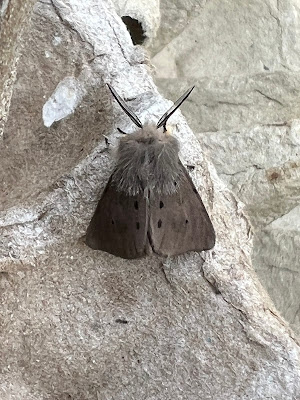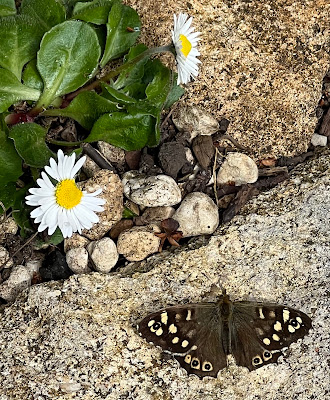Today's top moth is a really exciting find - not by myself but by a good buddy whose excitement I most happily share at second-hand. He is one of a number of people who kindly ask me from time to time about the identity of their garden discoveries, a rash thing to do as readers familiar with my many blunders will know.
This time, there was no doubt at all that he had found something extremely excellent, even though his consultations in books and online had led him to the tentative conclusion that it was a Burnished Brass. That's a lovely moth (or possibly moths as the scientific community is still debating whether its differing wing patterns justify dividing the species), but it is widespread. As Rupert said in his message:
"Predictably, it turns out to be something as common as muck in suburban gardens and not, as I was beginning to hope, some special rarity, previously unknown to science."
Not so fast!
He was on to the right family and the BB and his find do share the wonderful metallic sheen caused by reflective and refractive mirror wingscales. But there's nothing ordinary about this moth.
It is a Slender Burnished Brass, a North African species recorded fewer than 100 times in the UK and only five times on the Isle of Wight where my friend lives. He's the cartoonist Rupert Besley whose work you may know, especially in holiday postcards and book illustration. Here's an example as a tribute to his discovery:
And here's the griff on the Besley Moth from the Moth Bible which the island's moth recorder Jim Baldwin updated before happily registering Rupert's find. As Jim says, the moth is doubly unusual as most Slender BB records have been between July and October. His theory is that this one came over in food imported from North Africa by supermarkets or wholesalers - that's how it earns the title of 'adventist' being a species which takes advantage of such hitch-hiking.
and here are some of my own recent arrivals at the trap, mundane by comparison with the Slender Burnished Brass and its glorious scimitar of yellowy-green but still handsome enough: an Oak Beauty, an alert male Muslin Moth and a Lunar Marbled Brown with particularly distinctive crescent moons.
Numbers in the light trap have not been large because of cold nights, including even a short spell of frost, but the days remain sunny by and large and more butterflies are about. I saw but failed to photograph a Holly Blue on a bike ride last week and took a quick pic of a Small White - deadly enemy of our brassicas later in the year when I'm ashamed to say that I show them no mercy. Speckled Woods are also about in areas of dappled shade - the two photos below are of the same one, with the different light concealing and then showing the downy surface of the wings as they get closer to the body.
Apart from the cold, my moths also face an implacable and ruthless hunter in this Robin below, the cleverest in a long line of cunning monitors of my morning visits to inspect the contents of the eggboxes. I'm glad to say that I kept him away from the Waved Umber, Clouded Drab, Powdered Quaker and three pugs, an Oak Tree and two Dotted.
Other insect visitors in the last week have included this bright Red Mite among a very small sample of the countless seeds produced by a Paulownia tree in the grandchildren's garden, a plump Hornet which I nearly squashed while repairing the treehouse roof (fortunately they are very docile in spite of their fearsome size and colouring) and these Ladybirds enjoying the sun on a fruit cage in the beautiful gardens at Rousham, five miles up the road from here. Aphid beware! Hungry Ladybirds are currently emerging all over the place from their Winter sleep.




















No comments:
Post a Comment